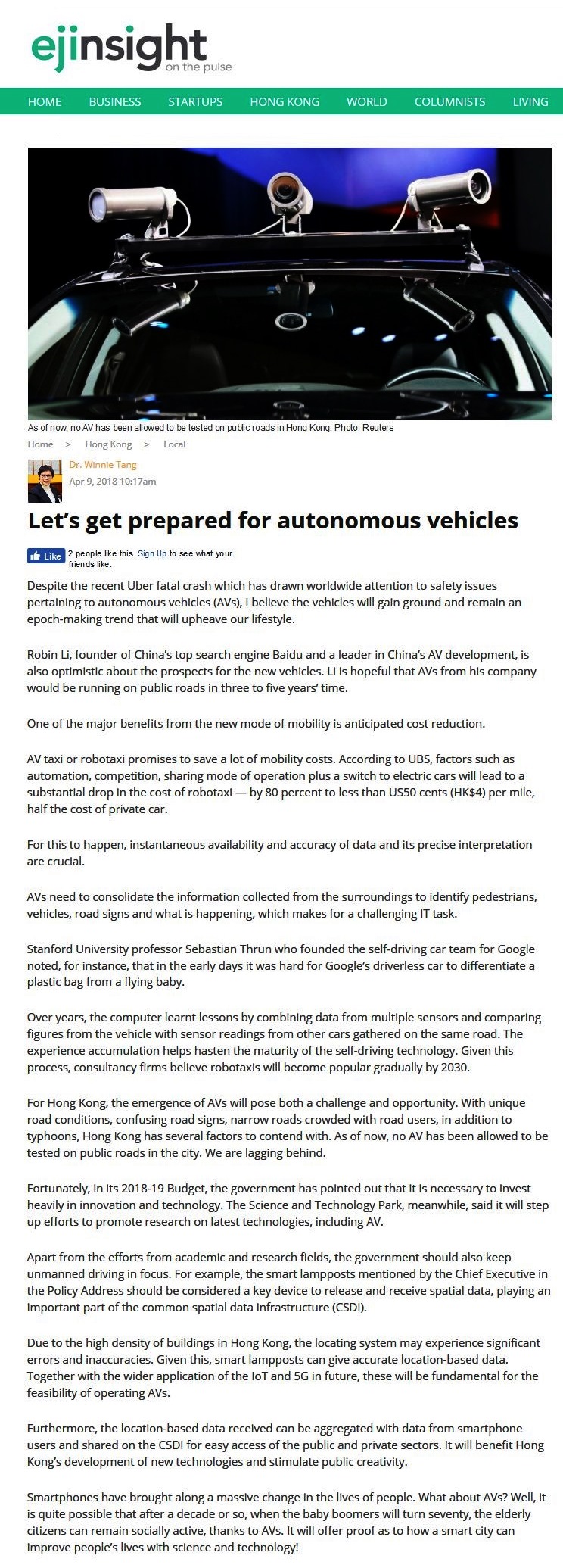網上版請按此

Let's get prepared for autonomous vehicles
Despite the recent Uber fatal crash which has drawn worldwide attention to safety issues pertaining to autonomous vehicles (AVs), I believe the vehicles will gain ground and remain an epoch-making trend that will upheave our lifestyle.
Robin Li, founder of China's top search engine Baidu and a leader in China's AV development, is also optimistic about the prospects for the new vehicles. Li is hopeful that AVs from his company would be running on public roads in three to five years' time.
One of the major benefits from the new mode of mobility is anticipated cost reduction.
AV taxi or robotaxi promises to save a lot of mobility costs. According to UBS, factors such as automation, competition, sharing mode of operation plus a switch to electric cars will lead to a substantial drop in the cost of robotaxi — by 80 percent to less than US50 cents (HK$4) per mile, half the cost of private car.
For this to happen, instantaneous availability and accuracy of data and its precise interpretation are crucial.
AVs need to consolidate the information collected from the surroundings to identify pedestrians, vehicles, road signs and what is happening, which makes for a challenging IT task.
Stanford University professor Sebastian Thrun who founded the self-driving car team for Google noted, for instance, that in the early days it was hard for Google's driverless car to differentiate a plastic bag from a flying baby.
Over years, the computer learnt lessons by combining data from multiple sensors and comparing figures from the vehicle with sensor readings from other cars gathered on the same road. The experience accumulation helps hasten the maturity of the self-driving technology. Given this process, consultancy firms believe robotaxis will become popular gradually by 2030.
For Hong Kong, the emergence of AVs will pose both a challenge and opportunity. With unique road conditions, confusing road signs, narrow roads crowded with road users, in addition to typhoons, Hong Kong has several factors to contend with. As of now, no AV has been allowed to be tested on public roads in the city. We are lagging behind.
Fortunately, in its 2018-19 Budget, the government has pointed out that it is necessary to invest heavily in innovation and technology. The Science and Technology Park, meanwhile, said it will step up efforts to promote research on latest technologies, including AV.
Apart from the efforts from academic and research fields, the government should also keep unmanned driving in focus. For example, the smart lampposts mentioned by the Chief Executive in the Policy Address should be considered a key device to release and receive spatial data, playing an important part of the common spatial data infrastructure (CSDI).
Due to the high density of buildings in Hong Kong, the locating system may experience significant errors and inaccuracies. Given this, smart lampposts can give accurate location-based data. Together with the wider application of the IoT and 5G in future, these will be fundamental for the feasibility of operating AVs.
Furthermore, the location-based data received can be aggregated with data from smartphone users and shared on the CSDI for easy access of the public and private sectors. It will benefit Hong Kong's development of new technologies and stimulate public creativity.
Smartphones have brought along a massive change in the lives of people. What about AVs? Well, it is quite possible that after a decade or so, when the baby boomers will turn seventy, the elderly citizens can remain socially active, thanks to AVs. It will offer proof as to how a smart city can improve people's lives with science and technology!
Dr. Winnie Tang
Honorary Professor, Department of Computer Science, The University of Hong Kong